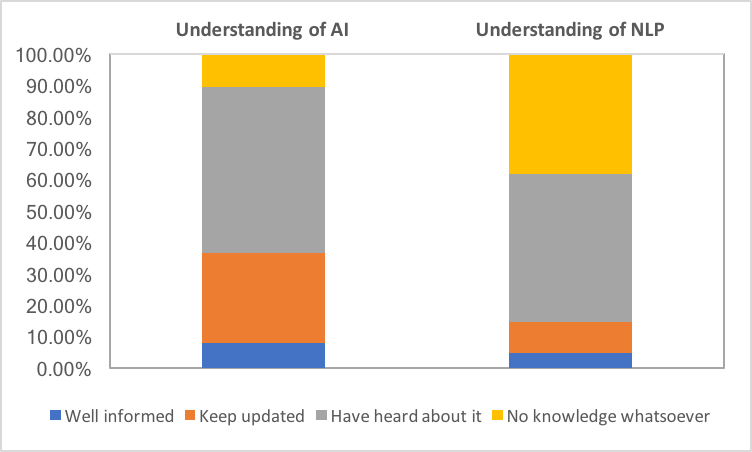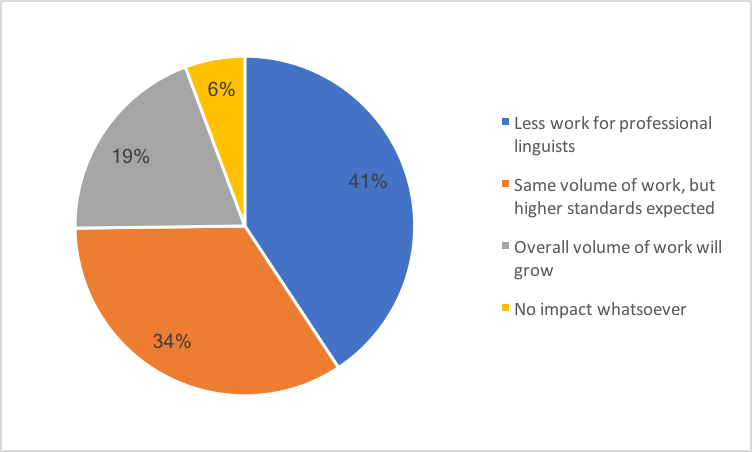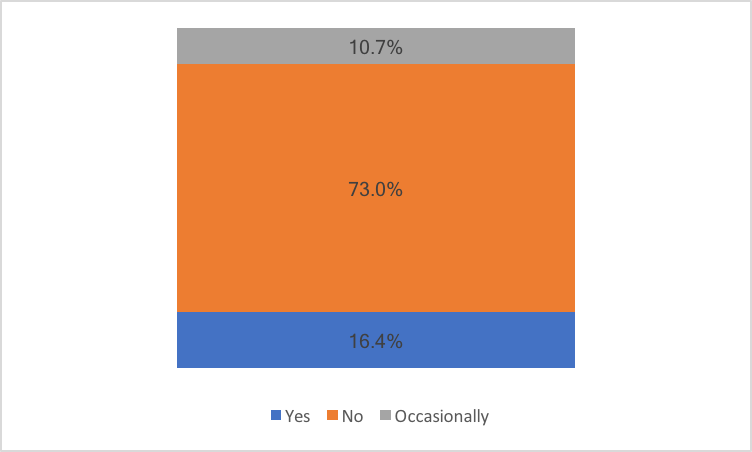To find out, Locaria ran a survey with 150 participating linguists from across the globe. The survey was a combination of questions that required them to select from a list of answers, or give their view in their own words. An essential part of the survey saw each linguist describe their feelings towards AI, NLP, and machine translation. This was fundamental in gauging the current mood.
Let’s take a closer look at the results.
Awareness of AI and NLP of people providing languages services
Considering the amount of publicity AI and machine translation solutions have received recently, the results here were surprising.
One might assume that professional linguists would feel a constant need to stay updated on any impact such technology may have on their future careers. Results from the survey paint a different picture:

About half of all participating linguists had heard about the technology. Surprisingly, only about 28% of language professionals keep updated about AI, which is known even to people working in industries without any current application for AI or NLP. A shocking 38.2% have no knowledge whatsoever.
While linguists are aware of machine translation tools — after all who hasn’t heard of Google Translate? — there is an apparent lack of understanding of the connection between AI, NLP, and advanced machine translation such as statistical machine translation (SMT) or neural machine translation (NMT).
Impact on future work for professional linguists
As popular translation tools expand their reach and are used more frequently, naturally professional linguists start to contemplate how it could affect the volume and nature of their work.

Almost half of the 150 linguists surveyed foresee a reduction in translation work. Roughly a third believe they will receive the same amount of projects, but as their job becomes more focused on quality assurance and revision, final quality standards will significantly rise. This could be a positive development for translation overall, since the focus would shift to creating perfectly adapted and original target language content.
Interestingly, nearly a fifth of language professionals surveyed think that work-load may grow with the increased usage of machine translation technology. This is likely, as content which isn’t professionally translated for reasons of budget or time constraints may be automatically pre-translated quickly and cheaply, while maintaining an accepted level of accuracy.
As the demand for pre-translated machine translation content surges, the need for quality assurance by professional linguists to add a human touch could also increase.
Where can machine translation help the professional linguist in the future?
Once the usage and purpose of statistical and neural machine translation are understood, most linguists start to think about how it could support them in their work instead of ignoring it as a threat to their livelihood.

Statistical machine translation is already used by many to get a rough understanding of texts written in foreign languages. As confidence in the quality of SMTs grows, perhaps using them for professional purposes will gain more acceptance.
How often do linguists use SMTs during their work?
It’s difficult to say how many linguists would admit to using SMTs for their translation projects, as despite improvements in the technology, its acceptance amongst clients is still low.
It’s no surprise that 73% of the linguists surveyed have claimed that they never use SMTs during their work. A few years ago, that percentage was probably more like 99% since SMTs were still so new and unreliable.
Therefore, the 16.4% of linguists who admit to using SMTs is potentially expected to grow, especially in the wake of highly advanced neuro machine translation technology.

General thoughts from linguists about the future of their work
When asked to summarise their thoughts on AI and NLP, all seemed to agree on one key point — humans can never be fully replaced.
There was an apparent split between two groups of people. There are those who see technology as an aid that could speed up the translation process. Meanwhile, many believe that people will begin to accept substandard language quality, and adapt to a new reality in which every piece of content will be translated entirely by machines.
We need to take a step back and understand how we produce and develop language. Where and how do our natural methodologies fundamentally differ from any machine-produced content?
I very much doubt that the concerns of the latter group will materialize. We humans are excessively sensitive and protective of our languages. However, that doesn’t mean we won’t embrace AI translation. It instead depends on how intelligently we can weave technology into our natural language production processes to facilitate, or further enrich it.
Comments